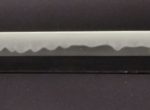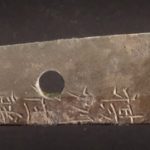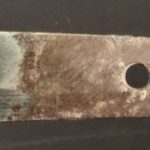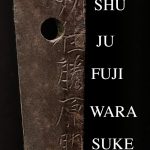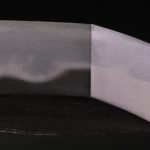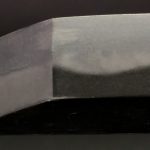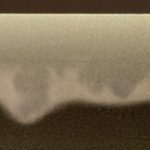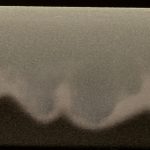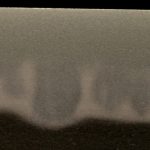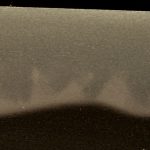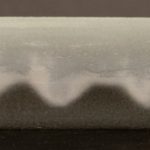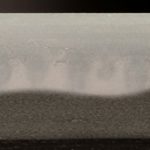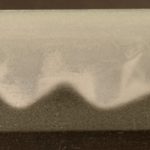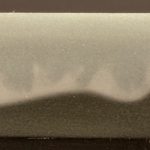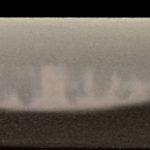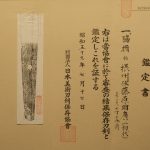SUKEHIRO / SHODAI / SAIJO-O-WAZAMONO
SUKEHIRO
SHODAI
C. 1652-1655
NBTHK HOZON
RATING/RANKINGS/VALUES:
FUJISHIRO: JOJO SAKU
KOKIN KAJI BIKOSEN (YAMADA YOSHICHIKA): SAIJO -O- WAZAMONO
HAWLEY’S 80 pt.
TOKO TAIKAN 6,000,000 ¥
MEI: SESSHU JU FUJIWARA SUKEHIRO
DATE: NONE c. 1652-1655
NAGASA: 20.625″
OVERALL: 26″
MIHABA: 1.18″
KASANE: 0.25″
SORI: 0.125″
NAKAGO: UBU
MEKUGI ANA: ONE
YASURIME: SUJIKAI
MUNE: IORI
HADA: KO-ITAME with MASAME ALONG THE SHINOGI JI
HAMON: CHOJI MIDARE
BOSHI: KOMARU
HORIMONO OMOTE: NONE
HORIMONO URA: NONE
HABAKI: 1 PC. SILVER
SHIRASAYA
Excellent example of the work a highly rated smith, Shodai (1st generation) Sesshu Sukehiro. This wakizashi is a textbook example of Sukehiro’s work. His works are rated 6 million Yen in the Toko Taikan. See more about Sukehiro below, courtesy of Seskos.
The polish is flawless, pristine and gorgeous. The sword comes in a high quality shirasaya.
REFERENCES:
Hawley’s (SUK 129) pg. 742 (80 pts)
Fujishiros Shinto Jiten pg. 477
Toko Taikan pg. 320 (6 million Yen)
Shinto Taikan pg. 272
Nihonto Koza IV pg. 138
Sesko’s, Swordsmiths A-Z pg. 1000-1001
Courtesy of Sesko’s, Swordsmiths A-Z:
SUKEHIRO (助広), 1st gen., Jōō (承応, 1652-1655), Settsu – “Sukehiro” (助広), “Sesshū-jū Fujiwara Sukehiro” (摂州住藤原助広), “Sesshū Ōsaka-jū Sukehiro saku” (摂州大坂住助広作), “Sesshū Ōsaka-jū Fujiwara Sukehiro saku” (摂州大坂住藤原助広作), real name Tsuda Yahei (津田弥兵衛), he was born in Tsuda (津田) in the Hosoe district (細江) of Harima province, it is said that during his early years, he mass-produced blades in Tsuda, later he moved to Ōsaka where he studied under the 1st gen. Kunisuke (国助), a theory says that he got the nickname “Soboro Sukehiro” (そぼろ助広, lit. “ragged”) because of his raggedly dressing, others say that the nickname goes back to a blade which was signed by him with the katakana syllables “Sohoro” (ソホロ), this theory assumes that this was the nickname of the blade, because sohoro might be an old pronunciation of the term sōro (霜露) which means “white frost,” and some adopt this approach and see in sōro the characters (草露) which stand for “dew-covered grass,” a periphrase for the transience of all things, and others in turn assume that the supplement “Sohoro” on the tang in question was an uncommon way to refer to the use of orishigane. The 1st gen. Sukehiro died in the eleventh month of the third year of Kanbun (寛文, 1663), we know date signatures from the first year of Keian (慶安, 1648) onwards, he retired in Meireki three (明暦, 1657), the jigane is a dense ko-itame with fine ji-nie and masame along the shinogi-ji whereas some blades can also show utsuri, the hamon is mostly a chōji-midare in the style of the Ishidō school with a tight nioiguchi and ashi, the bōshi is sugu with a ko-maru-kaeri, the yasurime are ō-sujikai without keshō, saijō-ō-wazamono, jōjō-saku
This sword comes with a 48-hr. inspection period.
Please refer to the Policy Page for complete details.
$8000 plus S/H/I and any additional associated fees (pp, wire, etc.)
